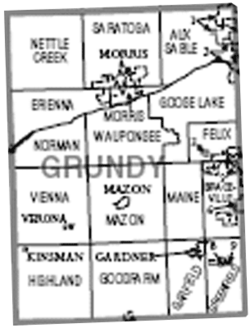Grundy County | |
|---|---|
 Grundy County Courthouse | |
 Location within the U.S. state of Illinois | |
 Illinois's location within the U.S. | |
| Coordinates: 41°17′N88°26′W / 41.29°N 88.43°W | |
| Country | |
| State | |
| Founded | February 17, 1841 |
| Named after | Felix Grundy |
| Seat | Morris |
| Largest city | Morris |
| Area | |
• Total | 430 sq mi (1,100 km2) |
| • Land | 418 sq mi (1,080 km2) |
| • Water | 12 sq mi (30 km2) 2.9% |
| Population (2020) | |
• Total | 52,533 |
• Estimate (2024) | 53,835 |
| • Density | 120/sq mi (47/km2) |
| Time zone | UTC−6 (Central) |
| • Summer (DST) | UTC−5 (CDT) |
| Congressional district | 16th |
| Website | www |
Grundy County is a county in the U.S. state of Illinois. According to the 2020 census, it has a population of 52,533. [2] Its county seat is Morris. [3]
Contents
- History
- Geography
- Climate and weather
- Major highways
- Adjacent counties
- Demographics
- 2020 census
- 2010 census
- Communities
- City
- Villages
- Former Communities
- Townships
- Unincorporated communities
- Politics
- Education
- See also
- References
- External links
Grundy County is part of the Chicago metropolitan area.
In 2010, the center of population of Illinois was in Grundy County, just northeast of the village of Mazon. [4]
Illinois's state fossil, the unique and bizarre Tully Monster, was first found in Mazon Creek. Grundy County is home to Dresden Generating Station—the first privately financed nuclear power plant built in the United States—and the Morris Operation—the only de facto high-level radioactive waste storage site in the United States.






